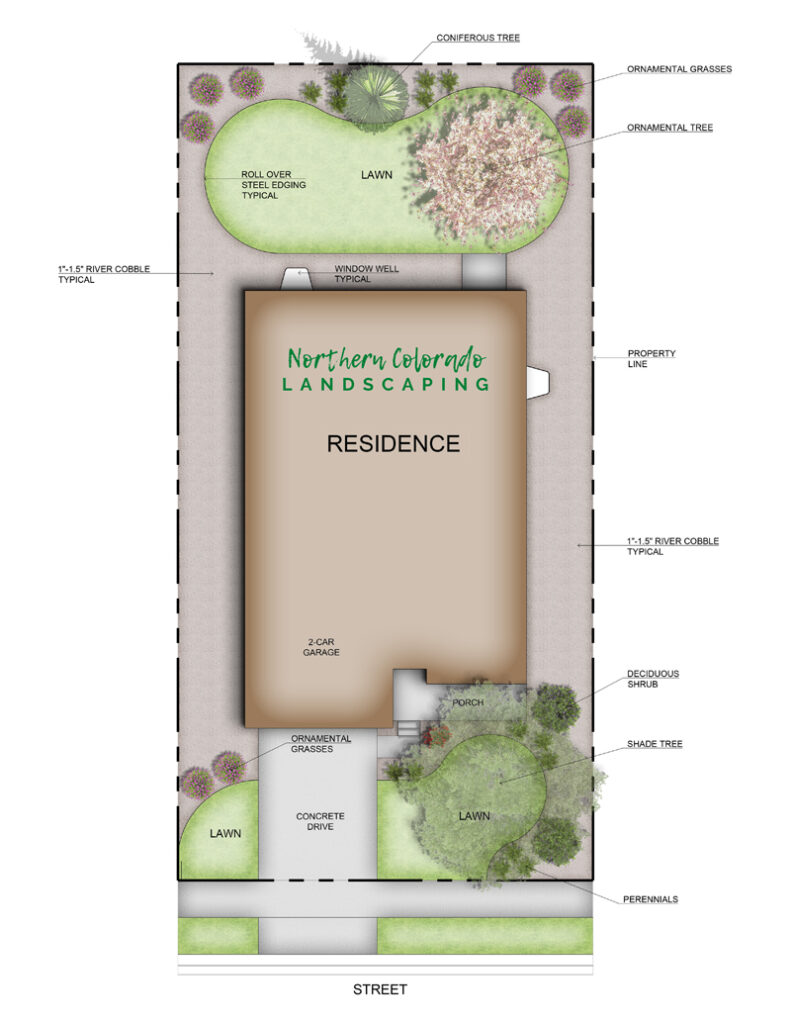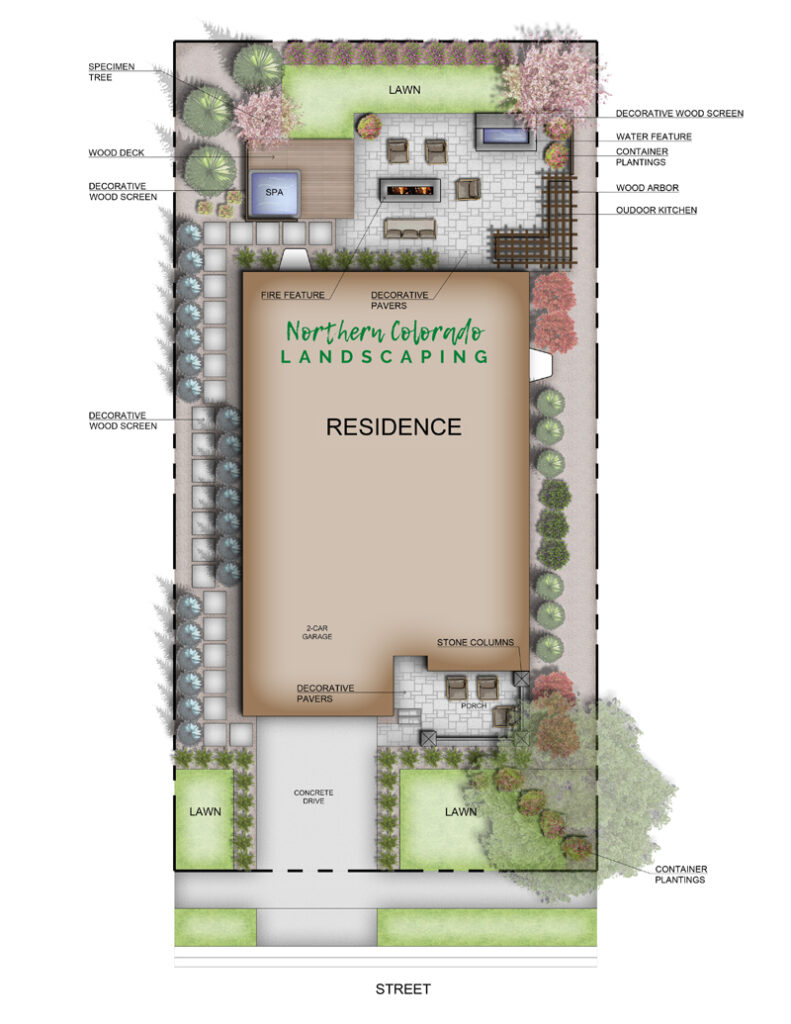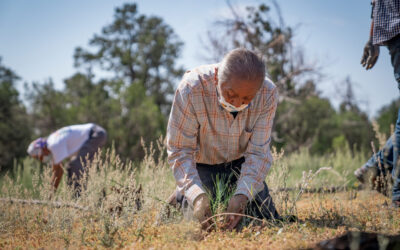The investment in your home is not confined to what is within its four walls; your exterior space can be one of the most cherished parts of the home.
However, it is often equally overlooked when it comes to new builds or upgrading your home. For many, understanding how to create a beautiful and functional exterior is overwhelming. This can be true of both new and resale homes; each have their distinct problems and solutions. They also have some similar considerations. And, by the way, just how much does a new landscape cost anyways?
Here to answer that question are Kristina and Taylor Portillo, husband and wife team and owners of Northern Colorado Landscaping in Berthoud. They have taken on a new-build home and given us three designs in three different price ranges to illustrate what money can buy, and the best way to enhance your outdoor space if you need to do it in stages.
New-build basics
The Portillo’s biggest piece of advice for new-build homeowners: do it right the first time. “Often homeowners move in real fast and have something thrown down only to rip it out later because it wasn’t done right or wasn’t what they wanted,” says Kristina. And, while some new builds may come with partial landscaping (usually the front yard), it will inevitably “look just like the neighbors’ house,” says Taylor.

Our example home
They remind us that the American Society of Landscape Architects recommends spending 5 to 10 percent of your home’s cost on landscaping—i.e., if you are buying a $500K home, plan $25K for that landscape. The problem is, says Kristina, many homeowners run out of money well before it comes to the last piece of their new home puzzle and the landscape takes the hit.
Be warned, they say, if the landscape is done on the cheap without a plan. Key elements like sprinklers and drip lines may not be appropriate or adequate when the time finally comes to install your dream landscape. The Portillos say they spend a lot of time ripping out landscaping that is only 2-3 years old to reinstall it in a way that works with the homeowner’s new plan.
To mitigate having the same work done twice, the Portillos recommend having a landscape design done at the beginning of the process, even if it is with the caveat that only a portion will be done at a time. This way, landscapes done in stages can still be upgraded without needless tear outs.
Other valuable pieces of advice for new-build homeowners? Check your HOA requirements before closing. Some neighborhoods require more expensive fencing or a certain number of plantings. Know before you close on the house and save yourself a headache.
Next, plan ahead. Landscapers can be booked out months in advance, and the design process does take some time. Don’t run up against an HOA deadline and not have a landscaper ready to go.
Finally, keep in mind that builder add-ons to a landscape can be more expensive than going with an outside landscaper. When looking for a landscaper, avoid the horror stories that the Portillos hear regularly. Make sure that your landscaper is easy to track down with a working phone number, website and address. Ask them if they are insured. Look at reviews online.
“A little bit of due diligence goes a long way here,” says Kristina.
Old landscape love
Older homes in need of a landscape reno have a lot of positives: established trees and plantings that provide shade and plenty of appeal. However, don’t expect a landscape reno to be cheaper than a new build, especially if there is a lot of rip-out to do.
As with new builds, start with a solid design. Often, older landscapes need TLC because of over planting done when the design was first installed.
“Landscapers will sometimes fill a space with a bunch of plants so it looks good right now,” says Taylor. But this only crowds them as they mature, and the lack of foresight means that maintaining those plantings may be impossible. Some will only last a couple years before they naturally die off.
Xeriscaping is often on a homeowner’s mind when they have landscaping redone. This is an opportunity to choose plantings that can survive in Colorado’s dry climate and to work with other materials that can cut down on watering.
Cut the costs
The Portillos do have a couple tips to cut the cost of your landscape design. But it all starts with that quality design done by a local landscaper: “Avoid those online quick-design plans,” says Kristina. “Often the person doing them is out-of-state and will offer up a plant list that might not even be available at local nurseries.”
To save some money, homeowners can purchase their own plants (try a local nursery instead of a big-box store; you can tap into a local nursery’s knowledge of what works and what doesn’t, and you will get long-lasting perennials, often guaranteed for a year). Homeowners can also dig their own holes to plant after the design and sprinklers are done.
Stamped concrete can be a lower cost over pavers, and walkways made with crushed granite (often called Breeze) is cheaper than concrete walks. Reducing the amount of sod can save on watering and sprinkler installation. Finally, buying smaller plants can help homeowners save a little money in their design, knowing that they will fill in as they mature.
Northern Colorado Landscaping took one typical new-build yard (this one located in RainDance, Windsor) and drew up plans for three different landscapes in three different price points to give readers an idea of what money can buy. Designs range from $15,000 to $75,000+.
Design 1

Price range: $15,000-20,000 Elements: This design allowed for a more custom landscape in the front yard than is standard in most new-build homes of this price range. Rounded corners in the design and a large ornamental tree add interest and shade. In the rear of the home, plantings and an ornamental tree complement the rounded lawn.
Design 2

Price range: $30,000-50,000 Elements: The increase in price allowed for a larger lawn area and additional plantings in the front of the home. A crushed granite path connects the front and back yards, and the backyard has a stone paver patio with firepit and pergola. Larger planting areas with landscape boulders give additional color and shade, which also increase privacy in the backyard.
Design 3

Price range: $75,000+ Elements: The highest price point allows for a larger decorative paver front porch with stone columns and more plantings in the front yard, a stone paver path to the backyard and additional plantings on both sides of the home. The backyard is an outdoor haven with large decorative paver patio, fire feature, outdoor kitchen, wood arbor, water feature, wood deck for a hot tub and multiple wood screens for added privacy. Plantings are larger with a greater number of large trees and colorful plantings.
What trees grow best in Colorado?
The Portillo’s recommendations for trees that grow well in Northern Colorado (all are in stock at Fossil Creek Nursery):
• Arnold Sentinel Austrian Pine
• Shademaster Honey Locust
• Brandywine Crab Apple
• Greenspire Linden
• Baby Blue Eyes Colorado Spruce
• Hot Wings Tatarian Maple
• Winter King Hawthorn
• Swamp White Oak
• Ohio Buckeye
About them
Northern Colorado Landscaping was the Portillo’s way home, you could say. Taylor was in oil and gas and travelled all over the U.S. for his work.
Kristina was from Berthoud and was dragging along her business degree waiting for the right opportunity. That came in 2019, when the couple decided it was time to lay down roots and returned to Colorado.
Taylor’s past landscape experience led them to open a full-service landscaping business. They survived a scary COVID-19 pandemic by the skin of their teeth, and have been planning and installing landscapes ever since.
They do everything from design to installation to maintenance. The company is five strong during the off-season and manage a team of 20 during the busy season. Northern Colorado Landscaping offers three design packages, starting at $250 and up based on the size of the lot and scope of work (backyard only vs. entire lot, basic landscaping vs. pool with outdoor kitchen—you get the drift).
___________________________
Angie Grenz is editor for NOCO Style.







